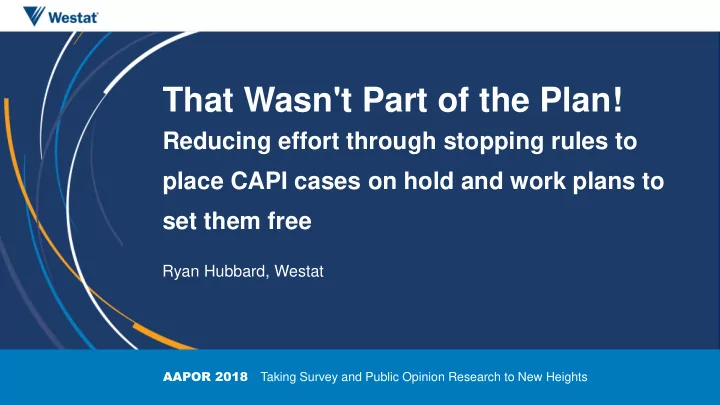

That Wasn't Part of the Plan! Reducing effort through stopping rules to place CAPI cases on hold and work plans to set them free Ryan Hubbard, Westat AAPOR 2018 Taking Survey and Public Opinion Research to New Heights
Background
What are Stopping Rules? • Stopping rules determine the amount of effort allocated to a case • Stopping rules are often enforced in CATI and CAPI to control cost • Attempt to maximize response rate given fixed resources • Designed to limit effort on cases unlikely to produce a complete • Require extensive review of attempt timing and quality • Can be adaptive as new paradata becomes available | AAPOR 2018 3
Stopping Rules: Advantages and Drawbacks Advantages Drawbacks • Limits unproductive attempts • Optimal rules difficult to establish without paradata – Limits labor costs – Allows for redirection of funds • Excludes cases that would complete – Promotes higher RR • Easy to implement • Ignores interviewer knowledge about particular cases • Rules can be adapted during • May increase risk for bias field period | AAPOR 2018 4
MEDICAL EXPENDITURE PANEL SURVEY (MEPS) Household Component (HC) • Yearly sample drawn from National Health Interview Survey (NHIS) • 5 rounds of CAPI per sample year (panel) at 6 month intervals • Collects over 25,000 interviews per year from respondent reporting for entire household • Provides annual estimates of health care cost and use as well as health insurance coverage for civilian U.S. population • Sponsored by Agency for Healthcare Research and Quality (AHRQ), U.S. Department of Health and Human Services - more info at https://meps.ahrq.gov/mepsweb/ | AAPOR 2018 5
MEPS On-hold Process
MEPS Stopping Rules…Pressing Pause • Spring 2017 MEPS HC collected data from three panels 2017 Panel 2016 Panel 2015 Panel Round 1 (new) Round 3 Round 5 • Differing rules applied to new panel versus existing panels – Existing Panels eventually settled on a 6 in-person attempt limit • Based on analysis of previous panel high attempt cases • Attempt limit lowered to stop work on additional cases – New panel based stopping rule on modeled propensity score • Based on new NHIS sample design – no previous data available • First round of a new panel has larger implications than later rounds | AAPOR 2018 7
Operationalizing the On-hold Process • Supervisors of interviewers with cases meeting limit messaged daily • The cases are transferred to an on-hold account for supervisor review • Upon review, a supervisor may draft a work plan for an on-hold case • With field manager approval of the detailed work plan, the supervisor may take the case off hold – we want to save viable cases! • Decision may be reevaluated later based on other pending cases • The bar is high for reintroducing a case to the field – Must distinguish cases in need of new strategy from low propensity | AAPOR 2018 8
Results
General Outcomes Attribute R3/5 R1 Net Sample 15188 10169 On Hold 245 391 Reintroduced with Work Plan 139 122 Complete 77 33 Percent Net Sample On Hold 1.6% 3.8% Percent On Hold Reintroduced 56.7% 31.2% Percent Reintroduced Completed 55.4% 27.0% Percent On Hold Completed 31.4% 8.4% Percent Net Sample On Hold Completes 0.5% 0.3% | AAPOR 2018 10
Attempt Reduction In-person Attempts Overall Attempts Per In-person Per Complete Attempt Count Complete Attempt Count Attribute Reduction Reduction Reduction Reduction R3 0.03 225 0.20 1499 R5 0.17 1313 0.12 927 Combined NA 1538 NA 2426 R1 0.92 9410 0.64 6137 Overall NA 10948 NA 8563 | AAPOR 2018
Effects of On-hold Implementation • Small changes add up to big results – over 8500 in-person trips averted • Specific Deterrence – Targeted cases received detailed scrutiny • Work stopped for some felt truly not viable • Smart work planned for others resulting in additional completes – Small number of cases on hold does not account for attempt reduction • General Deterrence – Field actively reviewed cases not yet at risk to avoid on-hold process – Curtailed excessive attempts or changed mode away from in-person | AAPOR 2018 12
Field Compliance and Buy-in • Field management shared ownership of on-hold process • Detailed review required for work plans aided compliance – Produced understanding for why a case was placed on hold – Fostered accountability for cases taken off hold • Supervisors began to pre-emptively ask for cases to be placed on hold based on independent review | AAPOR 2018 13
Next Steps
Improving the Stopping Rule Model • Model for Round 1 fits unique conditions but room for improvement – Many unknowns about cases – Chiefly in-person contact attempts – Higher levels of locating activity • Model used for R3/5 continuing sample is simple and less effective – More complex model may improve results – However, R3/5 RR very high so fewer high risk cases to identify | AAPOR 2018 15
Ideas or Questions? 16
Recommend
More recommend